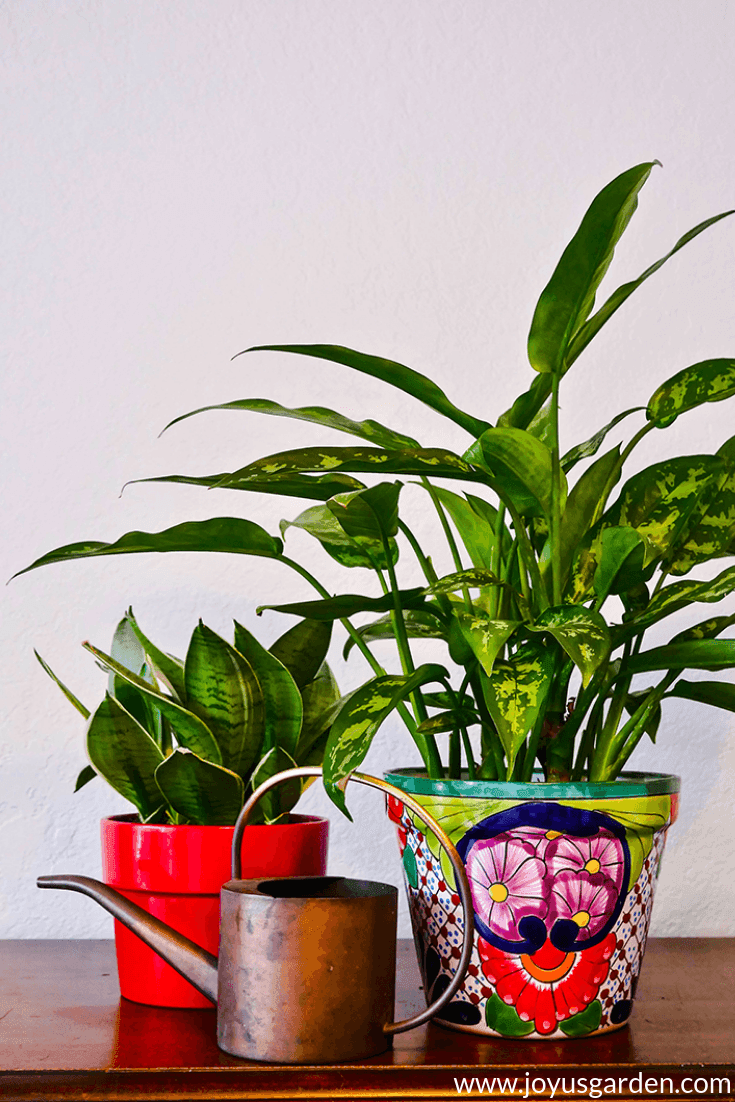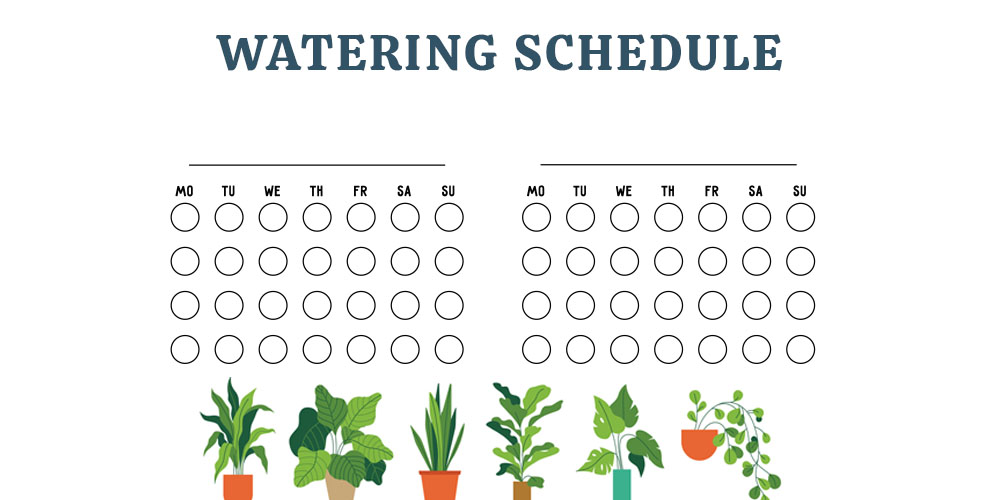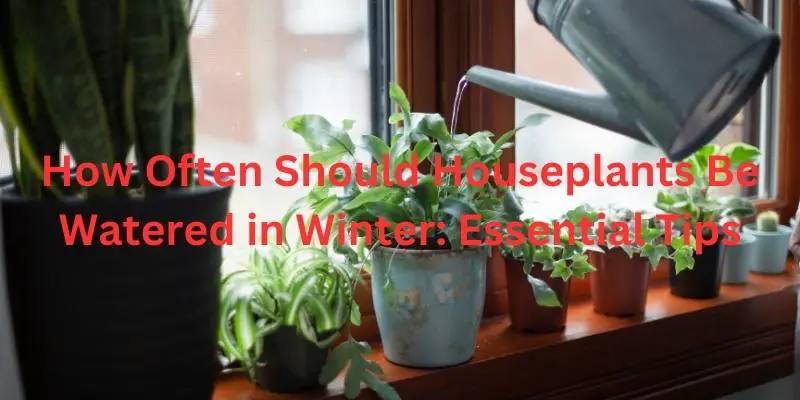Houseplants should generally be watered less frequently in winter, about every two to four weeks. Always check the soil’s moisture before watering.
Watering houseplants in winter can be tricky. They require less water due to reduced light and slower growth. Overwatering can lead to root rot and other issues. It’s crucial to monitor the soil’s moisture level. Insert your finger about an inch deep to feel if it’s dry.
If it is, it’s time to water. Use tepid water to avoid shocking the roots. Be mindful of the specific needs of each plant species. Some may need more frequent watering than others. Proper care ensures your houseplants stay healthy throughout the colder months.
Importance Of Winter Watering
Winter watering is crucial for houseplants. During winter, plants face different conditions. They need proper care to stay healthy.
Seasonal Changes
Winter brings shorter days and less sunlight. This affects plant growth. With less light, plants may need less water. The air also becomes drier due to indoor heating. Dry air can lead to quicker soil moisture loss. It’s important to check the soil regularly.
Plant Dormancy
Many plants enter dormancy in winter. Dormancy means slowed growth or rest. During dormancy, plants need less water. Overwatering can harm dormant plants. Water less frequently but ensure the soil stays slightly moist. Use a moisture meter to avoid overwatering.
| Plant Type | Watering Frequency |
|---|---|
| Cacti | Once a month |
| Succulents | Every 3-4 weeks |
| Tropical Plants | Every 1-2 weeks |
- Check soil moisture before watering.
- Reduce watering for dormant plants.
- Use a humidifier to maintain moisture levels.

Credit: www.extension.iastate.edu
Factors Affecting Watering Frequency
Understanding the factors affecting watering frequency in winter can help your houseplants thrive. During colder months, plants have different needs. Let’s explore how light levels and indoor temperature play crucial roles.
Light Levels
Light levels drop in winter. This reduction affects your plant’s water needs. With less sunlight, plants grow slower. They use less water. Place your plants near windows to maximize light. Choose south-facing windows for the best light. Avoid direct sunlight to prevent leaf burn.
Consider using grow lights. They can supplement natural light. Grow lights help maintain healthy growth. Adjust the light duration based on your plant’s needs. Common houseplants like succulents and cacti need 12-14 hours of light. Others, like ferns, need around 10 hours.
Indoor Temperature
Indoor temperature also impacts watering frequency. Colder temperatures slow down plant growth. This means they need less water. Keep your thermostat between 65-75°F (18-24°C). Avoid placing plants near heat sources. Heaters and radiators can dry out soil quickly.
Monitor humidity levels. Winter air is often dry. Use a humidifier to maintain 40-60% humidity. Grouping plants together can also help. This creates a microenvironment that retains moisture.
| Factor | Impact on Watering |
|---|---|
| Light Levels | Less light means less frequent watering |
| Indoor Temperature | Cooler temperatures reduce water needs |
| Humidity | Higher humidity means less frequent watering |
By understanding these factors, you can adjust your watering schedule. This ensures your houseplants stay healthy in winter.
Identifying Plant Needs
Understanding your houseplants’ water needs is crucial, especially in winter. During this season, plants often require less water. However, identifying the specific needs of each plant is essential. This guide helps you recognize signs of underwatering and overwatering to ensure your plants thrive.
Signs Of Underwatering
Underwatering can harm your houseplants. Look for these signs:
- Dry Soil: Check the top inch of soil. If it’s dry, your plant may need water.
- Wilting Leaves: Leaves may wilt or droop if your plant lacks water.
- Brown Leaf Edges: Leaves might develop brown, crispy edges when underwatered.
- Slow Growth: Plants can show stunted growth if they don’t receive enough water.
Signs Of Overwatering
Overwatering is a common mistake in winter. Watch for these signs:
- Yellowing Leaves: Leaves turning yellow can indicate too much water.
- Mushy Stems: Stems may become soft and mushy due to excess water.
- Fungus Growth: Mold or fungus on the soil surface is a sign of overwatering.
- Root Rot: Roots sitting in water can rot, harming your plant.
By observing these signs, you can adjust your watering routine. Each plant has unique needs. Pay attention to them to keep your houseplants healthy during winter.

Credit: www.joyusgarden.com
Best Watering Practices
Watering houseplants in winter can be tricky. Plants need less water due to slower growth. Understanding the best watering practices ensures healthy plants.
Watering Techniques
Use different techniques for different plants. Some plants need more water than others. Here are some common techniques:
- Top Watering: Pour water directly onto the soil. Ensure even distribution.
- Bottom Watering: Place the pot in a tray of water. Let the soil absorb water from the bottom.
- Misting: Spray water on the leaves. This helps plants needing high humidity.
Using The Right Amount
Using the right amount of water is crucial. Overwatering can cause root rot. Underwatering can cause plants to wilt.
Check soil moisture: Insert your finger into the soil. If the top inch is dry, it’s time to water.
Adjust for plant type: Different plants have different needs. For instance, succulents need less water compared to ferns.
| Plant Type | Watering Frequency |
|---|---|
| Succulents | Once every 2-3 weeks |
| Ferns | Once a week |
| Orchids | Once every 10 days |
Ensure proper drainage. Use pots with drainage holes. This prevents water from sitting at the bottom.
Choosing The Right Water
Watering houseplants in winter needs special care. The type of water you use matters. Different water types have different effects on plants. Choosing the right water can keep your plants healthy and happy.
Tap Water Vs. Filtered Water
Tap water is easy to access but can contain chemicals. These chemicals, like chlorine, can harm sensitive plants. Some plants might show signs of stress with tap water.
Filtered water removes many of these chemicals. It offers a cleaner option for your plants. Filtered water can be especially good for plants that are sensitive to tap water impurities. Using filtered water can lead to healthier growth and fewer problems.
Room Temperature Water
Water temperature also affects plant health. Room temperature water is best for watering plants. Cold water can shock the roots and cause damage. Warm water can speed up the growth but is not ideal in winter.
To ensure you are using the right temperature, let tap water sit out for a while. This will allow it to reach room temperature and release any chlorine.
| Type of Water | Benefits | Drawbacks |
|---|---|---|
| Tap Water | Easy to access | May contain harmful chemicals |
| Filtered Water | Cleaner and safer for plants | Requires a filter system |
| Room Temperature Water | Prevents root shock | Needs time to adjust temperature |
By choosing the right water, you can ensure your houseplants thrive during winter. This simple step can make a big difference in plant health and growth.
Soil And Pot Considerations
Winter can be tough on houseplants. They need special attention to stay healthy. Soil and pot considerations are crucial for proper watering. Let’s explore the key aspects.
Soil Type
The type of soil affects how often you should water. Some soils retain water better. Others drain quickly. Use well-draining soil for most houseplants. This prevents water from sitting too long.
| Soil Type | Water Retention | Recommended Plants |
|---|---|---|
| Clay Soil | High | None for houseplants |
| Sandy Soil | Low | Cacti, Succulents |
| Loamy Soil | Medium | Most houseplants |
Pot Drainage
Pots should have drainage holes. This helps excess water escape. Without drainage, roots may rot. Always check the bottom of your pots. Ensure holes are clear and not blocked.
- Use pots with built-in holes
- Add a layer of gravel at the bottom
- Consider using terra cotta pots
Poor drainage is a common issue in winter. Water evaporates slower. This can lead to overwatering. Be cautious and check the soil before watering.
Special Care For Different Plants
Winter can be a challenging season for houseplants. They need different care compared to warmer months. Understanding the water needs of various plants is essential. This guide will help you care for your houseplants in winter.
Succulents And Cacti
Succulents and cacti are hardy plants that store water in their leaves. These plants need less water in winter. Overwatering can harm them.
- Water sparingly, about once a month.
- Check the soil moisture before watering.
- Ensure the soil is well-draining.
Place them in a bright spot. They need sunlight to thrive. Avoid placing them near heaters or cold drafts.
Tropical Plants
Tropical plants require more attention in winter. They need a balance of water and humidity.
- Water when the top inch of soil is dry.
- Mist the leaves to increase humidity.
- Keep them away from cold drafts.
Use a humidifier if the air is dry. Grouping plants together can also help maintain humidity levels.
| Plant Type | Watering Frequency | Special Care Tips |
|---|---|---|
| Succulents and Cacti | Once a month | Check soil moisture, ensure good drainage |
| Tropical Plants | When top inch of soil is dry | Mist leaves, use a humidifier |
Winter care for houseplants varies by type. Knowing specific needs helps your plants thrive.

Credit: plantperfect.com
Monitoring And Adjusting
Winter can be a challenging season for houseplants. Understanding the importance of monitoring and adjusting watering routines is essential. During the colder months, plants require different care compared to warmer seasons.
Regular Checks
Regularly check the soil moisture of your houseplants. Stick your finger about an inch into the soil. If it feels dry, it’s time to water. Use a moisture meter for more accuracy. Inspect the leaves for signs of wilting or yellowing. These can indicate improper watering.
Adjusting For Plant Growth
Plants grow slower in winter. This means they need less water. Adjust your watering schedule accordingly. Younger plants may need more frequent watering. Older, established plants can go longer without water.
| Plant Type | Watering Frequency |
|---|---|
| Succulents | Every 2-3 weeks |
| Ferns | Weekly |
| Orchids | Every 7-10 days |
Adjust watering based on your plant’s specific needs. Monitor the growth and soil moisture regularly. Remember, overwatering can be as harmful as underwatering.
By staying vigilant and making necessary adjustments, you can keep your houseplants healthy throughout the winter season.
Frequently Asked Questions
How Often Should I Water Indoor Plants In The Winter?
Water indoor plants less frequently in winter. Check soil moisture weekly. Water when the top inch feels dry.
Should I Still Water My Plants In The Winter?
Yes, water your plants in winter but less frequently. Check soil moisture before watering to avoid overwatering.
How Do You Keep Potted Plants Alive In The Winter?
Keep potted plants alive in winter by moving them indoors. Water sparingly and ensure adequate light. Avoid drafts and maintain moderate humidity. Use proper insulation for outdoor pots.
Do Indoor Plants Go Dormant In The Winter?
Yes, some indoor plants go dormant in winter. They may show slower growth and need less water and light.
Conclusion
Monitoring your houseplants in winter is crucial for their health. Adjust watering based on plant type and environment. Remember, most houseplants need less water during colder months. Check soil moisture regularly to prevent overwatering. By following these tips, your houseplants will thrive throughout the winter season.
Keep them happy and healthy.

My mission is to help you bring the beauty of nature indoors with expert advice, detailed plant care guides, and creative design ideas.





Leave a Reply